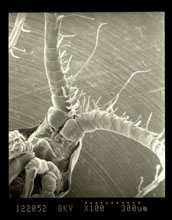Multimedia Gallery
Chemical Mating Signals (Image 2)
Chemical Mating Signals (Image 2)
Scanning electron micrograph of the antennule of the female subtropical predatory pelagic copepod Euchaeta rimana, a type of zooplankton. Often, a male copepod goes the wrong way on a female's pheromone trail, then turns around and swims more erratically as he searches for the narrow trail. He uses the sensors on his long antennae to compare from side to side. This is his strategy for staying on the trail. As he does this, he messes up the trail and leaves behind what looks like a spiral helix.
This image was taken as part of a study of chemical signals involved in copepod mating by Georgia Institute of Technology professor Jeannette Yen. Yen is studying the mating patterns of zooplankton--short-lived organisms that range in size from several microns to a few centimeters. Zooplankton live in oceans and almost all other aquatic habitats, traveling with the flow of water. Although they are abundant, the probability of finding a mate for the millimeter-sized copepod (one of several types of zooplankton Yen is studying) is low because they are widely dispersed in a huge ocean, often living in a dark environment where vision is limited, and they lack image-forming eyes.
To make up for their visual impairment, copepods and other zooplankton communicate with potential mates by chemical signals. To attract a mate, females emit chemical compounds called pheromones that are slowly dispersed by molecular diffusion, not by the flow of the water. (Date of Image: 2003) [Image 2 of 3 related images. See Image 3.]
Credit: Geoffrey Boxshall, The Natural History Museum, UK, and Jeannette Yen, Georgia Institute of Technology
Special Restrictions: For personal, editorial, non-commercial/nonprofit use only.
Images and other media in the National Science Foundation Multimedia Gallery are available for use in print and electronic material by NSF employees, members of the media, university staff, teachers and the general public. All media in the gallery are intended for personal, educational and nonprofit/non-commercial use only.
Images credited to the National Science Foundation, a federal agency, are in the public domain. The images were created by employees of the United States Government as part of their official duties or prepared by contractors as "works for hire" for NSF. You may freely use NSF-credited images and, at your discretion, credit NSF with a "Courtesy: National Science Foundation" notation.
Additional information about general usage can be found in Conditions.
Also Available:
Download the high-resolution JPG version of the image. (533 KB)
Use your mouse to right-click (Mac users may need to Ctrl-click) the link above and choose the option that will save the file or target to your computer.



